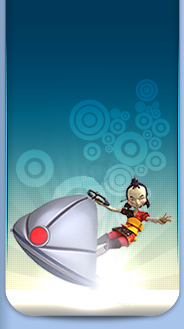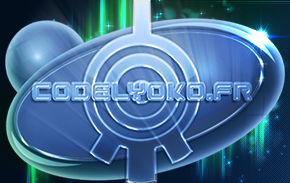
|
 |
Interview with Thomas Romain
| | | Here is an interview with Thomas Romain (co-creator of Code Lyoko alongside Tania Palumbo) that took place when Code Lyoko was released on Netflix on the 1st of October 2020. This interview was held by Jérôme Lachasse for the website of the news channel BFM TV. It has been translated from French. | | |
|  | How did you come up with Code Lyoko? What was the original idea?
The series project wasn't the vision of just a single person. Developing it was really a group effort. The starting point was Garage Kids, the final project short film I made [at Gobelins] with Tania Palumbo in 2000. It's aged since then but it's a little film I'm still proud of today and still feels meaningful. It shows a small group of kids from the suburbs meeting up to screen their own animated film in an improvised theatre in an abandoned car park. The producers at Antefilms (later named Moonscoop) really liked its atmosphere and they gave us an offer to make a series together.
How were the Matrix and Tron films an influence in creating the virtual world of Lyoko?
I hadn't seen Tron back then but Matrix really left its mark on me, as I really enjoy science fiction and dystopian universes. It had enormous influence - there's the same concept of a machine that lets you dive into a virtual world and the presence of an operator who supervises the trip, as well as the correlation between the action in the virtual world and in the real world. As for Asia, Japanese animation was also an influence for us. I mean, I've been living in Tokyo and working as an animator there since 2003. Our reference series at the time were Serial Experiment Lain and Evangelion, among others. You can see the worrying digital dimension in Lain, as well as the presence of dangerous and impressive entities that have to be fought against, like in Evangelion.
Artificial intelligence plays a very important role in Code Lyoko. How did you get that idea?
We didn't do any thorough research on the subject at the time. Tania and I were only 22 or 23 and the series was definitely born from various influences and intuitions. Initially, it was the Antefilms producers who gave us the idea of the video game theme. But we didn't want to make a series that was too playful and superficial, so we thought up episodes that were tense, suspenseful, and even had tragic scenes. Things that are hard to imagine seeing in a cartoon series for kids.
Tragic scenes? Did you want to kill off one of the 4 main characters?
Not necessarily, but trying as hard as we could to get around the censoring done by TV channels that tend to "soften" programmes aimed at kids and teens.
Where does the word "Lyoko" come from?
It comes from the Japanese word "ryoko-" which simply means "voyage," referencing the concept of voyaging into the virtual world.
How were the characters conceived? What were your influences?
The characters were born from Tania Palumbo's pencil when we were making our final project film. After that, we gave them names and personalities. The way the characters looked was the main thing that kicked off the project. From an artistic point of view, we were influenced by the Japanese animator Koji Miromoto and his angular, graphic style, and the strange, dark, cyber universe.
Where did the names Yumi, Ulrich, Odd and Jérémie come from?
If I remember correctly, they were mainly Tania's ideas. Odd, which means "strange" in English, was chosen to emphasise his unconventional side. It was very unique at the time to have a character who didn't adhere to the classic male gender norms. Jérémie's first name is a wink to the creator Jérémie Périn (Lastman) who was our friend from class and whom we were already fans of.
What did Tania Palumbo bring to the Code Lyoko project?
She did an enormous amount of work. Though I was there right at the start helping to get the project concept started, Tania was the artistic director through all the years the series was being produced. Notably she designed all the main characters and their outfits.
Tania Palumbo doesn't seem to have done anything since Code Lyoko. Does she still work in animation?
It seems that despite her immense talent, she quit the world of animation. It can be very tough. It's competitive and demands an enormous amount of investment, sometimes an unreasonable amount. Like any other profession, there are also a number of cases of harassment and burnout. I know Tania didn't come out unscathed and must have been suffering through some points in her career.
Was the idea of mixing 2D and 3D a natural requirement?
It was in the Antefilms studio specifications, as at the time, they were one of few studios who were producing hybrid series mixing 2D and 3D. They had to keep their 3D team up and running, and the idea of representing these scenes in 3D was new and a great selling point.
Compared to the virtual world, reality in the series seems rather dull...
Paradoxically, a huge effort was made to create the backgrounds in the real world. A team of excellent 2D background artists was recruited to give the environments a realistic look. There was also a lot of reference work done. For example, Kadic Academy is modelled on Lycée Lakanal, a real school in Sceaux (92), which I'd been to. The abandoned factory, a central location in the series, is based on the old Renault factory on the Ile Seguin, which has since been demolished. It was taken very seriously because at the time, a lot of French animation studios set their series in fantastical or Americanised locations, as the producers probably thought their cartoons were more likely to get exported that way. Tania and I wanted to represent the France we knew, particularly the outskirts of Paris.
You conceived Garage Kids as a serial. Why did Code Lyoko end up being episodic?
My dream was really to create a serial, but French TV channels don't like this kind of series because they like to broadcast and rebroadcast the episodes at varying hours of the day and without needing to worry about which order they should be in. Episodes of a serial are more difficult to schedule, and it can be difficult for people to take interest in a series in the middle of its run. Unfortunately, the writing team therefore developed the episodes as independent from one another, for the most part.
At what point did Garage Kids become Code Lyoko? What happened between 2000 and 2003?
The series was developed under the name Garage Kids. At the time, the video game aspect was barely present, and the heroes' powers could be brought from the virtual world into reality. After I left the project [in 2003] and after the series was sold to TV channels, it was renamed Code Lyoko and lost its ambition to be a serial. For my part, I did everything I could to go work in Japan.
Was the series difficult to produce? How were your relationships with the producers, the Di Sabatino brothers?
I didn't take part in the production [Editor's note: he left the project in 2003]. My relationships with the Di Sabatino brothers were almost nonexistant. After the series gained great commercial success, I tried to find out what the studio had earned from it, in the hopes of being given my contractual dues (there were sales of books, video games, figurines, etc.) but I never got a response, and I didn't see a cent of what the producers earnt from the series.
Now MoonScoop is closed, who has the rights to the series?
The production copmany Ellipsanime holds the rights. I think they could start making new episodes if they wanted to.
In retrospect, what is your view on the series?
When we were developing the project, we had no idea it would be such a huge success. I left the project not knowing what the result would be and went into the Franco-Japanese production of Oban Star-Racers. I followed the fan craze from afar in Japan. I'm glad so many people like the series, really I am, but since I was only involved in the initial development, I don't consider myself part of the team. I was able to make a name for myself in the world of animation afterwards, and people often contact me just to talk about Code Lyoko. But it was really the artists, writers, animators, etc. who worked on the production who were able to make Code Lyoko into a French animation success story.
When the series was being written, did you ever want to take bigger risks and deviate from the general episode formula (XANA attack on Earth, trip to Lyoko, tower deactivation), despite opposition from the TV channels who would never have allowed it?
No, I never felt censored. I think the concept kept its promises, with the only constraint being that the stories that were told had to be suitable for children aged 6 to 12. The fact that the series is well liked by people older than that proves that we wrote much more complicated scripts than the original concept allowed us to envisage.
Code Lyoko still has enthusiastic fans to this day. The two tweets for Netflix's announcement were liked more than 140,000 times even though the series is already available on Amazon Prime and YouTube. How would you analyse the continual popularity of Code Lyoko's renewal?
I think the series came at the right time, with a topic that fits with the development of the Internet and new technologies. It didn't treat children like idiots; it gave them plenty of stuff thematic of science-fiction such as episodes with an exciting structure or stories that make you think. The romantic relationships between the teenage characters also contributed a lot to its success, I think. Mix that in with a catchy theme song and you have all the ingredients to make the audience nostalgic for it. It's not impossible that the series could see a revival if the rights holders decide to do so. Who knows? |  | |
|
 |





